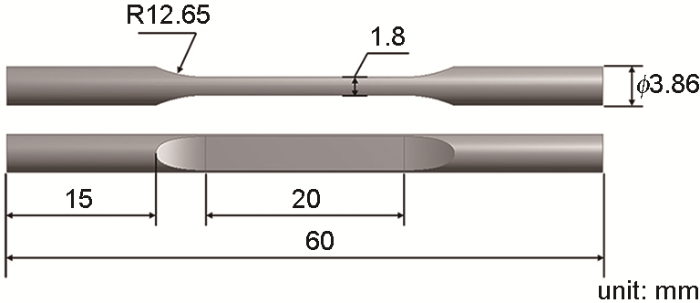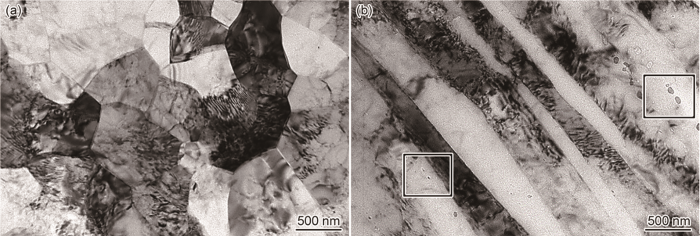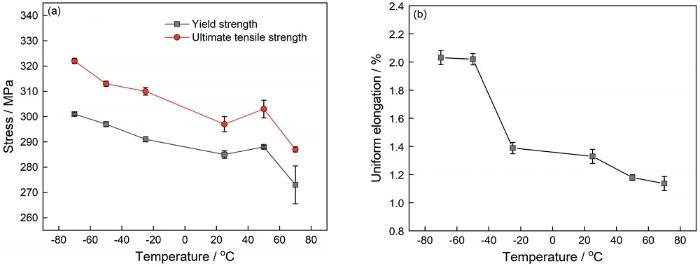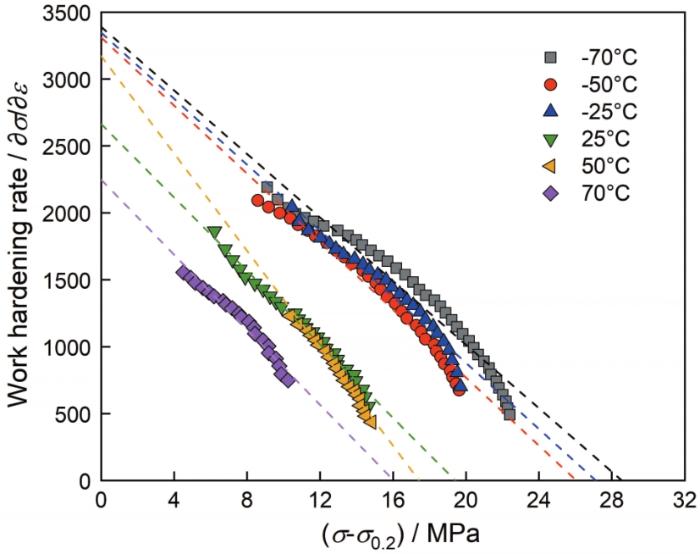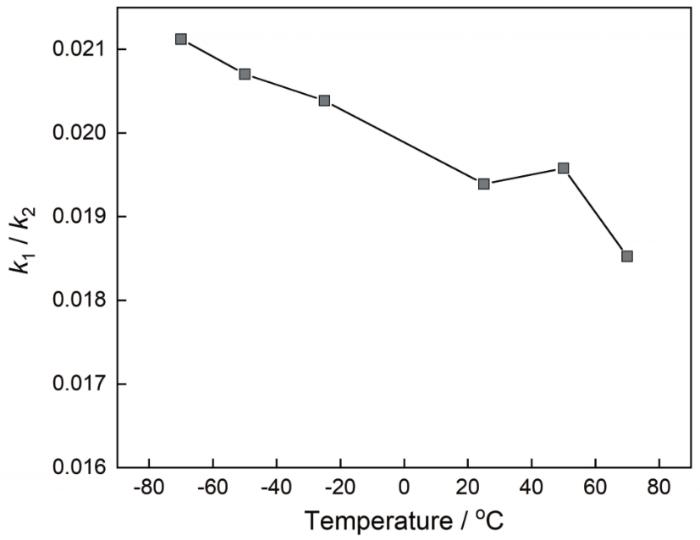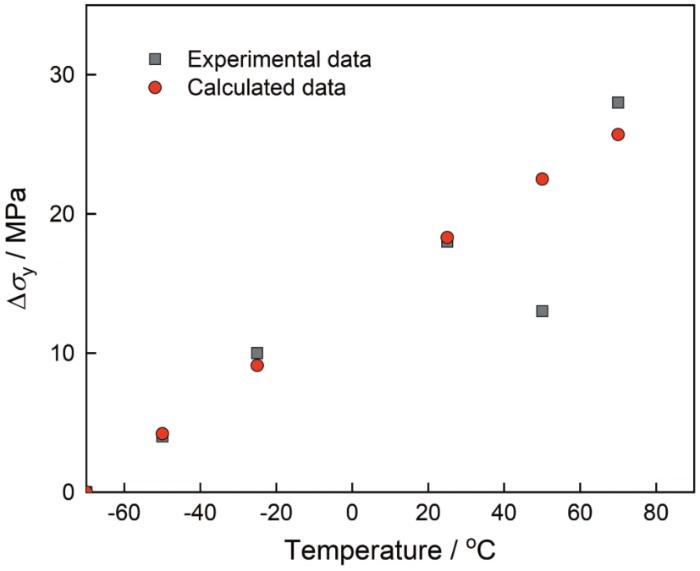在远距离输电过程中架空导线在不同的环境温度下服役,特别是在极端气候条件下架空导线表面覆冰。以往的相关研究工作,主要是关于提高导线用材料的电导率和耐热性能[5~7]。研究发现,铝合金拉伸强度极限和屈服强度都随着温度的降低而提高[8~10],与材料中位错的运动和热激活有关[11, 12]。在低温下变形使材料中生成高密度位错[13],位错运动受阻[14~16]使材料具有较高的强度。但是,输变电行业仍希望有最直观的理论预测模型,能预测服役过程中导线的塑性流变应力与服役温度间的定量关系,为导线的实际应用提供理论和实际应用依据。鉴于此,本文研究商用6101铝合金线缆的单线在-70℃ 到70℃温度区间的拉伸性能以及变形温度对其热稳定性能的影响。
1 实验方法
实验用的材料为6101商业铝合金线缆,其单股导线的直径为3.86 mm,化学成分(质量分数)为:Mg 0.35%~0.8%,Si 0.3%~0.7%,Fe 0.5%,Cu 0.1%,Zn 0.1%,Mn 0.03%,Cr 0.03%,Al 97.74%~98.59%。
使用DK7745电火花数控线切割机将合金导线裁切成长度为60 mm的短棒并加工成拉伸试样,尺寸如图1所示。在不同温度下的拉伸实验在INSTRON5982电子万能材料实验机上进行,恒温保温系统的温度控制精度为±1℃。实验温度范围从-70℃到70℃,用液氮制冷得到低温(-70℃、-50℃、-25℃);使用电加热恒温系统得到高温(25℃、50℃、70℃)。在每个温度下单轴拉伸实验测试三个样品,使用引伸计测量拉伸过程中的应变,应变速率为1.0×103 s-1,每次拉伸加载前将样品在预设温度下保温5 min。
图1
图1
6101铝合金导线的拉伸试样示意图
Fig.1
Schematic illustration of dimensions of the tensile specimens
用Leo Supra 35扫描电子显微镜(SEM)观察样品的拉伸断口形貌。用JEM-2100F透射电子显微镜(TEM)观测样品的微结构,加速电压为200 kV;TEM样品的制备:分别沿着原始样品的横截面和纵截面切取厚度约为1.5 mm的薄片,将其机械减薄至0.08 mm后再冲成直径为3 mm的圆片,用体积比为1:9的硝酸甲醇溶液进行电解双喷减薄,减薄温度为-20℃,电压为30 V。
2 实验结果
2.1 微观组织和结构
图2
图2
6101铝合金导线原始样品的横截面和纵截面的透射电镜照片
Fig.2
TEM images of cross-sectional (a) and longitudinal-sectional (b) of the as-received specimens
2.2 拉伸性能
样品在不同温度下的拉伸工程应力-应变曲线,如图3a所示。可以看出,样品在不同温度下的拉伸性能不同,表明温度对其强度和均匀伸长率都有显著的影响。样品真应变为0.2%~0.35%时的真应力-应变曲线如图3b所示,可见不同温度下的应力-应变曲线均出现轻微的锯齿状流变现象,这与拉伸过程中发生的Portevin-Le Chatelier(PLC)效应[18] 有关。对图3b中应力波动幅值(Δσ)的统计结果表明,不同温度下的Δσ都在0.27 MPa附近轻微波动。由此可以判断,在本实验的应变速率1.0×103 s-1和温度(-70℃~70℃)范围内,样品在拉伸变形过程中发生的PLC效应对温度没有明显的响应。
图3
图3
在不同温度下样品的工程应力-应变曲线和应变量为0.2%~0.35%条件下的真应力-应变曲线
Fig.3
Stress-strain curves of the specimens tested at different temperatures engineering (a) and true stress-strain curve at the true strain range of 0.2%~0.35%(b)
图4给出了样品的拉伸性能与温度的关系。由图4a可见,随着拉伸温度的提高样品的屈服强度(
图4
图4
6101铝合金导线试样的拉伸强度极限、屈服强度和均匀伸长率与温度的关系
Fig.4
Relationship between ultimate tensile strength and yield strength (a), uniform elongation (b) and temperature
2.3 断口形貌
在不同温度下样品的拉伸断口的SEM照片,如图5a~f所示。可以看出,在所有温度下的拉伸断口都出现大量的韧窝,其断裂模式为韧性断裂。对比分析不同温度下样品拉伸断口的结果表明,在-70℃拉伸断口的韧窝尺寸均匀。随着拉伸温度的提高断口上的韧窝表现出大小交叉、叠加分布的特征。但是与在-70℃的拉伸断口韧窝尺寸相比,在其余温度下拉伸断口的韧窝尺寸均变小和变浅(图5e和f)。据此可以推断,样品在-70℃、-50℃等低温拉伸过程中,在断裂前经历了较大的塑性形变;随着温度的降低断裂前的形变量逐渐增大,与图4a和b所示的曲线变化趋势相吻合,表现为随着样品拉伸温度的降低材料的强度提高、均匀延伸率变大。这可由图5a和e所示的在-70℃和50℃两种拉伸断口韧窝形貌的明显差异证实。图6a和b分别给出了在-70℃ 和70℃拉伸断裂后样品表面的SEM照片。可以看出,拉伸断裂后样品的表面有较多的垂直于拉伸轴方向的裂纹(图6a和b中线框标记部位)。无论是在低温(-70℃)还是在高温(70℃)拉伸,断裂后的样品表面都能观察到这类裂纹。这表明,样品拉伸变形时的裂纹萌生在样品的表面,在拉伸加载过程中裂纹不断扩展直至样品断裂。
图5
图5
在不同温度下拉伸样品断口的扫描电镜照片
Fig.5
SEM images of the fracture surfaces of the specimens tensiled at different temperatures (a) -70℃, (b) -50℃, (c) -25℃, (d) 25℃, (e) 50℃, (f) 70℃
图6
图6
在-70℃和 70℃断口附近样品表面的SEM照片
Fig.6
SEM images of the specimen surfaces close to fracture, tensiled at -70℃ (a) and 70℃ (b)
3 讨论
3.1 温度对应变硬化率的影响
图7
图7
不同温度下应变硬化率θ与流变应力增量(σ-
Fig.7
Curves of θvs (σ-
金属的应变硬化能力受控于位错储存与位错动态恢复之间的竞争。变形温度影响材料内位错的动态恢复速率,进而影响材料的应变硬化能力。材料的应变硬化过程与位错密度的变化关系密切,在材料的变形过程中流变应力与位错密度的关系可用Taylor公式[19]
描述。其中L为位错运动的平均自由程;
其中
表1 不同温度下样品拉伸参数
Table 1
| T/℃ | X | Y | Formula of strain hardening rate | ||
|---|---|---|---|---|---|
| -70 | 28.5 | 3389 | 1.674 | 79.275 | θ=39181(1-σ/330) |
| -50 | 26.1 | 3309 | 1.751 | 84.521 | θ=41108(1-σ/323) |
| -25 | 27.0 | 3346 | 1.684 | 82.617 | θ=39408(1-σ/318) |
| 25 | 19.5 | 2663 | 1.765 | 91.043 | θ=41311(1-σ/303) |
| 50 | 17.4 | 3171 | 2.378 | 121.494 | θ=55656(1-σ/305) |
| 70 | 16.0 | 2247 | 1.734 | 93.625 | θ=40586(1-σ/289) |
图8
3.2 温度对屈服强度的影响
其中
其中μ为剪切模量;ν为泊松比。μ和ν为温度不敏感的力学性能指标,在T=0 K至室温的温度区间内,取μ和ν为定值,因此,
其中
铝合金材料常数的取值范围为:剪切模量26 GPa~28 GPa、泊松比0.32~0.34和熔点640℃~660℃,通常取μ=27 GPa、ν=0.33、
图9
图9
样品屈服强度增量的实验值和计算值
Fig.9
Experimental and calculated data of yield streng-th increment of the specimens
4 结论
(1) 在-70℃到70℃温度区间6101铝合金导线的静拉伸表现出较好的低温增强增韧,与-70℃的性能相比其70℃的强度极限和屈服强度分别降低了10.9%和9.3%。
(2) 6101铝合金导线的应变硬化率随着拉伸温度的降低而提高;温度对其屈服强度的影响主要源于对晶格摩擦应力的影响。
(3) 根据本文得到的拉伸屈服应力增量公式,可预测在不同温度下服役的6101铝合金导线屈服应力的变化量。
参考文献
Influence of AlB2 compound on elimination of incoherent precipitation in artificial aging of wires drawn from redraw rod extruded from billets cast of alloy AA-6101 by vertical direct chill casting
[J].
Modification of AA-6201 alloy for manufacturing of high conductivity and extra high conductivity wires with property of high tensile stress after artificial aging heat treatment for all-aluminium alloy conductors
[J].
Inoculation of transition elements by addition of AlB2 and AlB12 to decrease detrimental effect on the conductivity of 99.6% aluminium in CCL for manufacturing of conductor
[J].
Production status and development prospects of Al-Mg-Si alloy conductor
[J].
Al-Mg-Si合金导线的生产现状及其发展前景
[J].
Influence of Sc on microstructure and mechanical properties of Al-Si-Mg-Cu-Zr alloy
[J].
Effect of Zr addition on properties of Al–Mg–Si aluminum alloy used for all aluminum alloy conductor
[J].
Heat-resistant Al-0.2Sc-0.04Zr electrical conductor
[J].
Study of the mechanical properties of Al-Si-Cu alloy under low temperature
[J].
Al-Si-Cu合金低温力学性能的研究
[J].
Tensile properties of three kinds of aluminum alloys at low temperature
[J].
3种高强铝合金的低温拉伸力学性能研究
[J].
Tensile properties of 2519 aluminum alloy at low temperature
[J].
2519铝合金的低温拉伸力学性能
[J].
The effect of dislocation drag on the stress-strain behavior of F.C.C. metals
[J].
A consistent modified Zerilli-Armstrong flow stress model for BCC and FCC metals for elevated temperatures
[J].
Deformation behavior and microstructural evolution of 7075-T6 aluminum alloy at cryogenic temperatures
[J].
Impact deformation behaviour of Ti-6Al-4V alloy in the low-temperature regime
[J].
In situ neutron diffraction study of IF and ultra low carbon steels upon tensile deformation
[J].
High temperature deformation and fracture behaviour of 316L stainless steel under high strain rate loading
[J].
Effects of Excess Mg and Si on the Properties of 6101 Conducting Wire and Its Mechanism
[J].
过量Mg、Si元素对6101电工导线性能影响及机制
[J].
Low temperature deformation behavior of an electromagnetically bulged 5052 aluminum alloy
[J].
The Mechanism of Plastic Deformation of Crystals. Part I. Theoretical
[J].
Work-hardening of ferrite and microstructure-based modelling of its mechanical behaviour under tension
[J].
A unified phenomenological description of work hardening and creep based on one-parameter models
[J].
Die Temperaturabhängigkeit der Versetzungsstruktur
[J].
Temperature dependence of the mechanical properties of equiatomic solid solution alloys with face-centered cubic crystal structures
[J].




